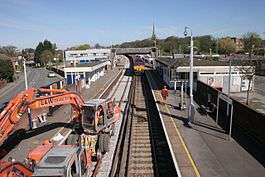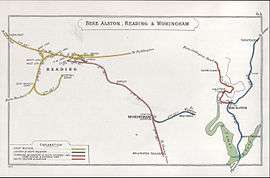Wokingham railway station
Wokingham railway station serves the market town of Wokingham in Berkshire, England. It is 36 miles 51 chains (59.0 km) down the line from London Waterloo. It is at the junction of the Waterloo to Reading line with the North Downs Line.
| Wokingham | |
|---|---|
 | |
| Location | |
| Place | Wokingham |
| Local authority | Wokingham |
| Coordinates | 51.411°N 0.843°W |
| Grid reference | SU805686 |
| Operations | |
| Station code | WKM |
| Managed by | South Western Railway |
| Number of platforms | 2 |
| DfT category | C2 |
| Live arrivals/departures, station information and onward connections from National Rail Enquiries | |
| Annual rail passenger usage* | |
| 2014/15 | |
| – Interchange | |
| 2015/16 | |
| – Interchange | |
| 2016/17 | |
| – Interchange | |
| 2017/18 | |
| – Interchange | |
| 2018/19 | |
| – Interchange | |
| History | |
| Original company | Reading, Guildford and Reigate Railway |
| Pre-grouping | London and South Western Railway |
| Post-grouping | Southern Railway |
| 4 July 1849 | Station opened |
| 1 January 1939 | Line electrified |
| 1973 | Station rebuilt |
| 1987 | Platforms lengthened |
| October 2013 | New station building opened |
| National Rail – UK railway stations | |
| |

South Western Railway manages the station and provides services along with Great Western Railway.[1]
History
The line from Reading to Redhill was built by the Reading, Guildford and Reigate Railway (RG&RR), and was opened in stages. The first sections, from Reading to Farnborough North, which included a station at Wokingham, also from Dorking West to Redhill, were opened on 4 July 1849. Other sections followed, with the last section, from Guildford (Surrey) to Shalford, on 15 October 1849.[2][3] From its beginning the RG&RR was worked by the South Eastern Railway (SER), which bought the RG&RR in 1852.[2]
The Staines, Wokingham & Woking Junction Railway (SW&WJR) opened a line between Staines and Wokingham (Staines Junction) on 9 July 1856. The London and South Western Railway (LSWR) worked the SW&WJR and was authorised to run over the SER to Reading.[4] This gave Wokingham a direct route to London Waterloo.
In 1933 the Southern Railway opened the current signal box. It controls part of the North Downs Line, part of the Waterloo route, and the level crossing. On 1 January 1939 the SR extended its Waterloo – Virginia Water electric service to Wokingham and Reading.[5]
In 1973 British Railways replaced Wokingham's station building with one built with CLASP prefabricated concrete sections. In 1987 BR slightly extended the platforms to accommodate eight-car Waterloo trains. Platform 2 ("down") has recently undergone a further extension to accommodate longer trains and the addition of a signal at the London end. This is for reversing trains in times of disruption and during the Reading station upgrade.
Level crossings
In 1976 BR converted the main level crossing next to the station from gates to barriers. There is also a footbridge for pedestrians to use when the crossing is closed for the passage of a train. The first bridge was built from old double-head rails, but has been replaced by a more modern angular design. There is a concrete footbridge in the 'V' of Wokingham Junction – where the Waterloo and North Downs lines meet.[6] There is also an occupation crossing located on the Waterloo line at Knoll Farm, opposite Langborough Recreation Ground, that it is restricted to use by the farm.
There is a very busy level crossing further along the same line on Easthampstead Road at Star Lane. BR installed automatic half-barriers (AHB) on it in about 1964. In 1997 Railtrack upgraded it to full barriers and equipped it with CCTV. BR equipped Waterloo Crossing with AHBs in 1965, and they remain in use today. BR also converted Amen Corner level crossing to AHBs, but in 1982 the A329 road was re-routed and two bridges were built to replace the Level crossing. The diverted road uses an overbridge nearer Wokingham station, and a pedestrian footbridge occupies the site of the former crossing.[7]
Services
South Western Railway runs a service between London Waterloo and Reading. This runs every 30 minutes daily, with some extra peak time weekday services in either direction.[8]
Great Western Railway runs an hourly semi-fast service between Reading and Gatwick Airport and an hourly stopping service between Reading and Redhill, giving a total service frequency of about two trains per hour on this route off-peak.[9] On Sundays, an hourly service operates on this route.
Wokingham station is an interchange for passengers between the Waterloo – Reading line and the North Downs Line.
| Preceding station | Following station | |||
|---|---|---|---|---|
| Winnersh | South Western Railway Waterloo to Reading line |
Bracknell | ||
| Reading | Great Western Railway North Downs Line semi-fast services to Gatwick Airport |
Blackwater | ||
| Great Western Railway North Downs Line local stopping services to Redhill |
Crowthorne | |||
Redevelopment 2013
In 2011, it was announced that Wokingham station would be redeveloped from spring 2012 to spring 2013[10] at a cost of £6 million.[11] The initial plan involved a new station building further along the platform, nearer to Reading than the existing building and creating a new spur road linking Wellington Road to the Reading Road. An artist's impression of the new station building was released to the news media in July 2011.[12] Enabling work for the link road was started on 11 February 2013.[13] In August 2013, the new footbridge was opened to the public and, in October the same year, the new station building was opened, with the old 1973 CLASP building being demolished to make way for the new station sign and clock tower.[14] However, following the development, South West Trains chose a new café chain to serve in the new building in place of that which had served in the old building, despite local opposition.[15]
Automatic ticket gates were installed at the station in early 2019.
Notes
- "Wokingham Station". National Rail.
- Kidner, R.W. (1982) [1974]. The Reading to Tonbridge Line. Locomotion Papers. Salisbury: Oakwood Press. p. 6. LP79.CS1 maint: ref=harv (link)
- Butt, R.V.J. (1995). The Directory of Railway Stations. Yeovil: Patrick Stephens Ltd. p. 253. ISBN 1-85260-508-1. R508.CS1 maint: ref=harv (link)
- Kidner 1982, p. 7
- Kidner 1982, p. 51.
- "Aerial View". Google Maps - Satellite view.
- "Aerial View". Google Maps.
- Great Britain eNRT 2015-16 Edition, Table 149 Network Rail
- Great Britain eNRT 2015-16 Edition, Table 148 Network Rail
- "Major improvements coming to Wokingham railway station". Wokingham Borough Council. 3 February 2011. Retrieved 25 March 2013.
- "Wokingham railway station gets £6 million upgrade". BBC Berkshire. 24 October 2012. Retrieved 25 March 2013.
- "First glimpse of new station". Wokingham Times. 6 July 2011. Retrieved 25 March 2013.
- "Enabling work starts on Wokingham station link road". Wokingham Borough Council. 15 February 2013. Retrieved 25 March 2013.
- "Old station demolished". Retrieved 20 November 2013.
- "Café owner's disgust". Retrieved 20 November 2013.
External links
| Wikimedia Commons has media related to Wokingham railway station. |